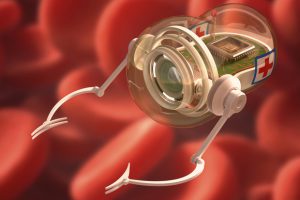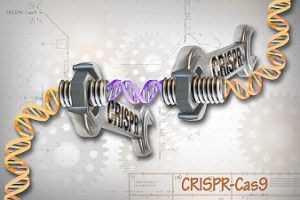[Editor’s Note: Army Mad Scientist teamed with the U.S. Army Sergeants Major Academy (SGM-A) at Ft. Bliss, Texas, in executing their annual writing contest for the fourth year in a row. Mad Scientist Laboratory is pleased to feature the SGM-A Class 73’s winning submission by Master Sergeant Greg A. McGowan as today’s guest blog post. Exploring the convergence of several themes familiar to our regular readers, MSG McGowan posits a future where the pursuit of Soldier overmatch may lead the Army to harness nanotechnology, neurotechnology, and Clustered Regularly Interspaced Short Palindromic Repeats (CRISPR) to ensure continued warfighter dominance and enhance recruiting and retention. While some may recoil at the associated ethical challenges that the transhumanist aspects of these technologies may portend, consider this — an asymmetry of ethics exists, where our autocratic adversaries’ whole-of-government commitment to modernization and the development of disruptive technologies will remain a key component of the Operational Environment for the foreseeable future. We can either engage in the pursuit of these capabilities (albeit within the confines of our ethical values and legal norms), or be relegated to a disadvantageous global position in the decades ahead — Read on!]
Universal Soldier
Imagination is the only limit to the development of future weapons used in warfare. Technological advancements on the battlefield play an instrumental role in determining global dominance. As weapons continue to merge with unimaginable technology, it is only a matter of time before Soldiers are forced to do  the same to survive on future battlefields. Future steps in human evolution will require blending humankind with technology to develop a warfighter capable of surviving in futuristic wars. To advance the capabilities of future Soldiers, the U.S. Government should explore the implementation of nanotechnology, neurotechnology, and Clustered Regularly Interspaced Short Palindromic Repeats (CRISPR) in our warfighters. Creating an advanced super Soldier is only a matter of time. Providing these advanced technologies in the U.S. Army will provide vast improvements in the recruitment and retention of Soldiers. According to O’Hanion (2018), military technology will advance faster over the next twenty years than in past decades. It is essential to find technological enablers that will allow for radical change. The U.S. military should take the lead in these developments to offer our warfighters the most advanced capabilities in the history of humankind. To remain dominant in global conflicts and maintain geopolitical influence, the U.S. should develop and integrate advanced scientific solutions to improve the warfighter’s intelligence, strength, and capacity to win the Nation’s wars.
the same to survive on future battlefields. Future steps in human evolution will require blending humankind with technology to develop a warfighter capable of surviving in futuristic wars. To advance the capabilities of future Soldiers, the U.S. Government should explore the implementation of nanotechnology, neurotechnology, and Clustered Regularly Interspaced Short Palindromic Repeats (CRISPR) in our warfighters. Creating an advanced super Soldier is only a matter of time. Providing these advanced technologies in the U.S. Army will provide vast improvements in the recruitment and retention of Soldiers. According to O’Hanion (2018), military technology will advance faster over the next twenty years than in past decades. It is essential to find technological enablers that will allow for radical change. The U.S. military should take the lead in these developments to offer our warfighters the most advanced capabilities in the history of humankind. To remain dominant in global conflicts and maintain geopolitical influence, the U.S. should develop and integrate advanced scientific solutions to improve the warfighter’s intelligence, strength, and capacity to win the Nation’s wars.
Nanotechnology
As the military continues developing scientific solutions for current, future, and unforeseen problems, nanotechnology is a primary area to explore. Nanotechnology can improve military equipment and medical treatment, allowing for advanced Soldier readiness. According to the National Nanotechnology Initiative (n.d.), nanotechnology consists of research, application, and engineering conducted at the nanoscale of 1 to 100 nanometers. For reference, a single grain of sand is about 500,000 nanometers in diameter, and a strand of human deoxyribonucleic acid (DNA) is 2.5 nanometers. Nanoscience creates the ability to see and manipulate individual atoms and molecules which make up all matter (National Nanotechnology Initiative, n.d.). Applying this technology to improve Soldiers’ health and readiness is a force multiplier.  Nanotechnology in medicine allows for early diagnosis of diseases, targeted drug delivery, tissue regeneration, and the ability to personalize medication to the individual Soldier. According to Percan et al. (2013), the ability to engineer tissue through nanoscience is a promising alternative for organ transplantation and treating burns to restore full vascular function. An additional medical benefit that will improve Soldiers’ health is the ability of nano medication to target specific locations. According to Rizvi and Saleh (2018), nanoparticle medication facilitates drug transportation through membranes and cellular walls within the body, targeting specific areas of need. Most current medications flood the whole body, treating areas that do not have symptoms and creating side effects that nanomedicines prevent.
Nanotechnology in medicine allows for early diagnosis of diseases, targeted drug delivery, tissue regeneration, and the ability to personalize medication to the individual Soldier. According to Percan et al. (2013), the ability to engineer tissue through nanoscience is a promising alternative for organ transplantation and treating burns to restore full vascular function. An additional medical benefit that will improve Soldiers’ health is the ability of nano medication to target specific locations. According to Rizvi and Saleh (2018), nanoparticle medication facilitates drug transportation through membranes and cellular walls within the body, targeting specific areas of need. Most current medications flood the whole body, treating areas that do not have symptoms and creating side effects that nanomedicines prevent.
In addition to the medical advancements that nanotechnology provides Soldiers, equipment improvements using the same science will improve tactical mobility and lethality. Nanomaterials have shown tremendous strength and energy absorption that future Soldiers could wear in combat.  Nanomaterials are incredibly light, allowing for greater mobility and improved protection. To elaborate, technology in nanomaterials is the ability to manipulate fibers at a nano level into the shape of cylindrical tubes. According to Shuangyuan et al. (2022), using nanotechnology to create body armor using materials shaped in pentagonal and hexagonal rings bonded at atomic sizes strengthens the material by 45% over conventional body armor. Nanotechnology used for designing and shaping materials at the nano level can also improve the strength and lower the weight of ballistic helmets and combat vehicles. Nanomaterials not only reduce weight but will improve bullet and shrapnel protection. In the not-so-distant future, nanotechnology will reach the point that the combat uniform, when made with a perfect blend of material and atomic formation, will provide enough ballistic capabilities that body armor is no longer necessary.
Nanomaterials are incredibly light, allowing for greater mobility and improved protection. To elaborate, technology in nanomaterials is the ability to manipulate fibers at a nano level into the shape of cylindrical tubes. According to Shuangyuan et al. (2022), using nanotechnology to create body armor using materials shaped in pentagonal and hexagonal rings bonded at atomic sizes strengthens the material by 45% over conventional body armor. Nanotechnology used for designing and shaping materials at the nano level can also improve the strength and lower the weight of ballistic helmets and combat vehicles. Nanomaterials not only reduce weight but will improve bullet and shrapnel protection. In the not-so-distant future, nanotechnology will reach the point that the combat uniform, when made with a perfect blend of material and atomic formation, will provide enough ballistic capabilities that body armor is no longer necessary.
Another advantage future Soldiers will require is the capacity for improved energy storage. As Soldiers spend more days away from sustainment in an expeditionary environment, their equipment becomes useless when conventional batteries drain. Nanotechnology is currently addressing this problem by changing energy storage capabilities. According to Deng et al. (2016), using unique self-assembling nanomembranes in three-dimensional formations will advance energy storage, becoming a renewable energy source.  The implication for this is that future Soldiers will have batteries that power their communication devices for weeks rather than days, at reduced weight and size. Another power generation advantage is the ability to store weeks of electricity in a battery no larger than a typical suitcase, negating the need to pull additional trailers with large generators. Now that future U.S. Soldiers have the advantage of energy storage, protective equipment, and medical treatment through nanotechnology, they will become even smarter using neurotechnology.
The implication for this is that future Soldiers will have batteries that power their communication devices for weeks rather than days, at reduced weight and size. Another power generation advantage is the ability to store weeks of electricity in a battery no larger than a typical suitcase, negating the need to pull additional trailers with large generators. Now that future U.S. Soldiers have the advantage of energy storage, protective equipment, and medical treatment through nanotechnology, they will become even smarter using neurotechnology.
Neurotechnology
To fight and win wars of the future when faced with unimaginable weapons, artificial intelligence can augment and increase human intelligence. Soldiers need the intellectual capacity to create advanced solutions to ill-structured problems in ways the current human brain cannot produce in a timely manner. The speed at which a country and its Soldiers analyze data and react optimally will factor heavily into future battlefield outcomes. Neurotechnology can provide U.S. Soldiers with this advantage. According to Muller and Rotter (2017), neurotechnology is the ability to link computers, mechanical  components, and intelligent prostheses with the human nervous system. In short, neurotechnology will create hybrid Soldiers capable of computing information at lightning-fast speeds. Typically, this will require brain implants, currently in production and testing phases at companies such as Neuralink. According to Neuralink.com (2023), their device is an implantable brain-computer that allows a human to manipulate software and body movements through electrical impulses.
components, and intelligent prostheses with the human nervous system. In short, neurotechnology will create hybrid Soldiers capable of computing information at lightning-fast speeds. Typically, this will require brain implants, currently in production and testing phases at companies such as Neuralink. According to Neuralink.com (2023), their device is an implantable brain-computer that allows a human to manipulate software and body movements through electrical impulses.
Current capabilities enable paralyzed people to perform essential functions such as controlling the mouse on a computer screen and opening and closing a prosthetic hand using brain waves or thinking about desired actions (Neuralink.com, 2023). Future implications of neurotechnology include integrating a fully implemented computer into the human brain. Instant access to advanced knowledge through thought will replace internet searching for information. Unimaginable intellectual advancements will occur when Neuralink-type implants connect to internet capabilities through satellites over the battlefield. The human brain could process information faster than currently available technologies, unlocking the capacity to commit new information to memory with astonishing recall accuracy. Mistakes and miscalculations during planning and decision-making processes may decrease to near zero. As developed nations implement neurotechnology into a human interface, wars will evolve into hacking minds to disrupt thought capabilities, ushering in a new era of cyberwarfare.
 Neurotechnology is not without ethical concerns. However, this is the natural path of evolution that humankind has set. Younger generations will not hesitate when presented with the opportunity to have computer-interfaced brain implants. According to Vergun (2021), the younger generation in the digital age is comfortable operating technically complex systems and will continue to grow technologically savvy. It is important to note that Soldiers of the future who do not adopt this technology will have a significant disadvantage in the world. Like students worldwide who cannot afford a computer or smartphone, or businesses that failed to adopt the internet and went bankrupt, early adopters will benefit the most. Interfacing neurotechnology and humans becomes as powerful as the source of information available. The better the artificial intelligence, the better the human. Early developments in artificial intelligence have already become available to general consumers.
Neurotechnology is not without ethical concerns. However, this is the natural path of evolution that humankind has set. Younger generations will not hesitate when presented with the opportunity to have computer-interfaced brain implants. According to Vergun (2021), the younger generation in the digital age is comfortable operating technically complex systems and will continue to grow technologically savvy. It is important to note that Soldiers of the future who do not adopt this technology will have a significant disadvantage in the world. Like students worldwide who cannot afford a computer or smartphone, or businesses that failed to adopt the internet and went bankrupt, early adopters will benefit the most. Interfacing neurotechnology and humans becomes as powerful as the source of information available. The better the artificial intelligence, the better the human. Early developments in artificial intelligence have already become available to general consumers.
ChatGPT, an artificially intelligent technology with natural language processing tools, is capable of humanlike conversations and advanced problem-solving. According to Delaney (2023), ChatGPT, when evaluated, has passed numerous medical, law, and business exams in multiple-choice and  essay-style testing. Combining this technology with a Neuralink device, the human Soldier may never require formal education. Additionally, the Army could use this future technology to make their Soldiers skilled in multiple languages and cultures. With advancements in nanotechnology and neurotechnology, advanced physical capabilities are the only component left to create a universal Soldier. Gene editing will account for this in future warfighters.
essay-style testing. Combining this technology with a Neuralink device, the human Soldier may never require formal education. Additionally, the Army could use this future technology to make their Soldiers skilled in multiple languages and cultures. With advancements in nanotechnology and neurotechnology, advanced physical capabilities are the only component left to create a universal Soldier. Gene editing will account for this in future warfighters.
Gene Editing
One of the most significant reasons Soldiers cannot deploy to combat results from medical issues, including behavioral health issues and physical limitations. According to Ferdinando (2018), over 280,000 service members are nondeployable at any given time, 13% of the total military. Non-deployability reduces readiness and puts additional strain on units to accomplish their mission with fewer personnel. To compound personnel shortage issues, recruiting is difficult, considering less than 30% of Americans meet the qualifications to serve (Myers, 2017). The future of physically and mentally  stronger Soldiers may lie in the power of gene editing. Gene editing can be accomplished via Clustered Regularly Interspaced Short Palindromic Repeats, or CRISPR. According to the National Library of Medicine (2022), CRISPR gene editing technology can alter DNA by removing undesirable traits and adding healthier, ideal genomes. Doctors and scientists using gene editing technology can treat and prevent diseases from cancer to mental illness and improve human characteristics such as athletic traits and cardiovascular function. Gene editing technology is in the early stages of development, but as recently as 2021 helped a blind woman see. According to Shwartz (2018), gene editing is like discovering and fixing a typo in a book, except it is in DNA, and the discrepancies consist of incorrect DNA sequences.
stronger Soldiers may lie in the power of gene editing. Gene editing can be accomplished via Clustered Regularly Interspaced Short Palindromic Repeats, or CRISPR. According to the National Library of Medicine (2022), CRISPR gene editing technology can alter DNA by removing undesirable traits and adding healthier, ideal genomes. Doctors and scientists using gene editing technology can treat and prevent diseases from cancer to mental illness and improve human characteristics such as athletic traits and cardiovascular function. Gene editing technology is in the early stages of development, but as recently as 2021 helped a blind woman see. According to Shwartz (2018), gene editing is like discovering and fixing a typo in a book, except it is in DNA, and the discrepancies consist of incorrect DNA sequences.
 An additional way that gene editing can benefit future Soldiers is through its preventive medicine capabilities. Gene editing opens a new field of debate for the future of biological warfare. According to Lau (2021), CRISPR technology allows bioterrorists to create extremely deadly biological weapons capable of quickly spreading diseases or altering human behavior. However, the same CRISPR technology can prevent illnesses resulting from biological weapons. Through gene editing and CRISPR technology, future Soldiers do not have to suffer from bioweapons due to their immunity. The ability to keep warfighters on the front line under biological contamination is a great benefit to continue advancing attacks. But potentially more impressive is the amount of money the U.S. Government would save in disability claims and the ability to extend the career of Soldiers lost due to illness and disease. Gene editing could provide Soldiers with healthier, fitter lives and prolong their peak fitness levels that typically degrade with age, resulting in a small number of Soldiers having the ability to serve twenty years or longer. According to the Peter G. Peterson Foundation (2022), the U.S. Government uses approximately 3% of the federal budget on veteran programs for a total of $234 billion in 2021, half of which result from a service-connected disability. As the cost of CRISPR technology becomes more affordable, the savings in health service costs become too great to ignore. In short, gene editing may open the pool of potential recruits, extend the
An additional way that gene editing can benefit future Soldiers is through its preventive medicine capabilities. Gene editing opens a new field of debate for the future of biological warfare. According to Lau (2021), CRISPR technology allows bioterrorists to create extremely deadly biological weapons capable of quickly spreading diseases or altering human behavior. However, the same CRISPR technology can prevent illnesses resulting from biological weapons. Through gene editing and CRISPR technology, future Soldiers do not have to suffer from bioweapons due to their immunity. The ability to keep warfighters on the front line under biological contamination is a great benefit to continue advancing attacks. But potentially more impressive is the amount of money the U.S. Government would save in disability claims and the ability to extend the career of Soldiers lost due to illness and disease. Gene editing could provide Soldiers with healthier, fitter lives and prolong their peak fitness levels that typically degrade with age, resulting in a small number of Soldiers having the ability to serve twenty years or longer. According to the Peter G. Peterson Foundation (2022), the U.S. Government uses approximately 3% of the federal budget on veteran programs for a total of $234 billion in 2021, half of which result from a service-connected disability. As the cost of CRISPR technology becomes more affordable, the savings in health service costs become too great to ignore. In short, gene editing may open the pool of potential recruits, extend the  expected capability to serve, allow Soldiers to stay on the front lines longer, and eliminate mental health issues in future Soldiers. Imagination is the only limit to the capabilities future technologies may provide warfighters.
expected capability to serve, allow Soldiers to stay on the front lines longer, and eliminate mental health issues in future Soldiers. Imagination is the only limit to the capabilities future technologies may provide warfighters.
Imagine the Possibilities
A genetically and technologically advanced civilization is the natural course in the evolution of humankind. For centuries, advancements in humans have vastly improved knowledge, physical strength, and life expectancy. In the not-so-distant future, it is not only Soldiers who will have access to these evolutionary advancements. Naturally, early adopters of future technologies will begin with high-income civilians. As future technologies’ prices decrease and become attainable for the general consumer, the military will not have the luxury of waiting on the sideline to adopt nanotechnology, neurotechnology, and gene editing.
 Through refined and updated versions of neural implants, educational institutions will meet the same fate as record players and drive-in movie theaters. Few colleges will exist as nothing more than nostalgic relics available as an alternative means to learn. In the future, for a relative price in attaining a degree today, humans will download their chosen profession directly into their minds, with available updates as knowledge advances in their field of work. According to Inafuku et al. (n.d.), the human mind is a complicated computer that functions on an electrochemical foundation and it is a matter of time before neural structures fully integrate into modern-day computing capabilities. Incentivizing human scientific advancements will vastly improve U.S. Army recruitment and retention.
Through refined and updated versions of neural implants, educational institutions will meet the same fate as record players and drive-in movie theaters. Few colleges will exist as nothing more than nostalgic relics available as an alternative means to learn. In the future, for a relative price in attaining a degree today, humans will download their chosen profession directly into their minds, with available updates as knowledge advances in their field of work. According to Inafuku et al. (n.d.), the human mind is a complicated computer that functions on an electrochemical foundation and it is a matter of time before neural structures fully integrate into modern-day computing capabilities. Incentivizing human scientific advancements will vastly improve U.S. Army recruitment and retention.
Recruitment and Retention Implications
 Access to future technologies will remain too expensive for most working-class individuals. The military may have the opportunity to recruit talented citizens by offering skills and military occupational specialties that will download directly into a Soldier’ implanted device. Immediate access to job knowledge will reduce the time needed for initial entry training, placing Soldiers in their units almost immediately. Skill levels will remain consistent with the time in grade and experience in the Army. For instance, a mechanic who applies satisfactory skills at ten-level duties and achieves three successful years in the Army will gain access to skill level two knowledge through a software download. Slowly developing and allotting downloadable knowledge will afford career growth while limiting the costs of Soldiers that do not stay beyond their initial contract. In the future, as neurotechnology phases out the need for colleges, recruiting the most capable officers will follow in a similar style. However, selecting officer candidates may primarily result from behavioral testing before commissioning and granting access to advanced secret or top-secret information and skill sets. Recruitment may also improve, allowing civilians who previously failed to meet health requirements to serve after gene modifications, such as curing asthma.
Access to future technologies will remain too expensive for most working-class individuals. The military may have the opportunity to recruit talented citizens by offering skills and military occupational specialties that will download directly into a Soldier’ implanted device. Immediate access to job knowledge will reduce the time needed for initial entry training, placing Soldiers in their units almost immediately. Skill levels will remain consistent with the time in grade and experience in the Army. For instance, a mechanic who applies satisfactory skills at ten-level duties and achieves three successful years in the Army will gain access to skill level two knowledge through a software download. Slowly developing and allotting downloadable knowledge will afford career growth while limiting the costs of Soldiers that do not stay beyond their initial contract. In the future, as neurotechnology phases out the need for colleges, recruiting the most capable officers will follow in a similar style. However, selecting officer candidates may primarily result from behavioral testing before commissioning and granting access to advanced secret or top-secret information and skill sets. Recruitment may also improve, allowing civilians who previously failed to meet health requirements to serve after gene modifications, such as curing asthma.  Applying gene editing advancements to cure common diseases or disabilities will open a broader range of candidates for enlistment. Gene editing procedures would work as enlistment bonuses for highly qualified candidates selecting high-priority occupational specialties.
Applying gene editing advancements to cure common diseases or disabilities will open a broader range of candidates for enlistment. Gene editing procedures would work as enlistment bonuses for highly qualified candidates selecting high-priority occupational specialties.
Retention rates will climb with Soldiers who value world-class healthcare. According to Miller (2018), a survey showed that six out of ten employees in the U.S. said that liking their health coverage is a critical factor when deciding to stay at their current job. Offering a gene editing, quality of life opportunity to Soldiers who make a career decision to enlist indefinitely will retain talent. For example, restoring vision loss or treating degenerative disc disease as a reenlistment option will improve job satisfaction and retention. Suppose the Army offers neurotechnology, nanotechnology, and gene editing packages as recruitment and reenlistment bonuses — this could yield an abundance of applicants, enabling the Army to choose only the highest quality candidates to serve.
Conclusion
 As the future of warfighting continues to gain perspective, it becomes more evident that the evolution of warfighters becomes more substantial and more intelligent through technological advancements to win future wars. Nanotechnology could provide light, mobile equipment to advance power storage, ballistic protection, and medical advancements tailored to the individual. Neurotechnology could promote the intellectual capacity of Soldiers to that of advanced artificial intelligence. Additionally, neurotechnology could provide a more outstanding quality of life for veterans injured in war with mind-controlled prostheses. Lastly, gene editing and CRISPR technologies could open the doors for sustained combat operations through bacterial and biological immunity and cure previously untreatable diseases resulting in the ability for the average Soldier to serve years longer than previously possible. Technological advancement in the knowledge, skills, and health of Soldiers could enhance recruitment and retention efforts. The future of warfare is uncertain. What is certain is the requirement to act in the evolution of the future warfighter, blending technology and humankind. Science holds the key to human advancement. Failure to lead in the sciences of nanotechnology, neurotechnology, and gene editing may result in the loss of major wars and geopolitical influence. What seems like science fiction today could be common practice tomorrow. Future generations may not hesitate when offered advanced technological capabilities of physical and mental strength, regardless of what ethical pundits believe.
As the future of warfighting continues to gain perspective, it becomes more evident that the evolution of warfighters becomes more substantial and more intelligent through technological advancements to win future wars. Nanotechnology could provide light, mobile equipment to advance power storage, ballistic protection, and medical advancements tailored to the individual. Neurotechnology could promote the intellectual capacity of Soldiers to that of advanced artificial intelligence. Additionally, neurotechnology could provide a more outstanding quality of life for veterans injured in war with mind-controlled prostheses. Lastly, gene editing and CRISPR technologies could open the doors for sustained combat operations through bacterial and biological immunity and cure previously untreatable diseases resulting in the ability for the average Soldier to serve years longer than previously possible. Technological advancement in the knowledge, skills, and health of Soldiers could enhance recruitment and retention efforts. The future of warfare is uncertain. What is certain is the requirement to act in the evolution of the future warfighter, blending technology and humankind. Science holds the key to human advancement. Failure to lead in the sciences of nanotechnology, neurotechnology, and gene editing may result in the loss of major wars and geopolitical influence. What seems like science fiction today could be common practice tomorrow. Future generations may not hesitate when offered advanced technological capabilities of physical and mental strength, regardless of what ethical pundits believe.
If you enjoyed this post, check out the following related content:
The Intelligent Battlefield of the Future and associated podcast, with proclaimed Mad Scientist Dr. Alexander Kott
Cyborg Soldier 2050: Human/Machine Fusion and the Implications for the Future of the DOD and its associated report from the U.S. Army Combat Capabilities Development Command (DEVCOM) Chemical Biological Center
China’s Brain Trust: Will the U.S. Have the Nerve to Compete? by proclaimed Mad Scientist Dr. James Giordano, as well as his Neuroscience, Neurotechnology, and the Future of War and Neuroscience and the Weapons of War podcasts, hosted by our colleagues at the Modern Warfare Institute
Linking Brains to Machines, and Use of Neurotechnology to the Cultural and Ethical Perspectives of the Current Global Stage and Designer Genes: Made in China? by proclaimed Mad Scientist Dr. James Giordano and Joseph DeFranco
Unplanned Obsolescence, by Eric X. Hammes
Dead Deer, and Mad Cows, and Humans (?) … Oh My! by proclaimed Mad Scientists LtCol Jennifer Snow and Dr. James Giordano, and Joseph DeFranco
Chatty Cathy, Open the Pod Bay Doors: An Interview with ChatGPT and associated podcast, with Chatty Cathy, an instance of ChatGPT by OpenAI
Recruiting the All-Volunteer Force of the Future, by proclaimed Mad Scientist Caroline Duckworth
Sine Pari, Keeping the Edge, CRISPR Convergence, and Great Power Conflict: 2040, by proclaimed Mad Scientist Howard R. Simkin
Connected Warfare by COL James K. Greer (USA-Ret.)
Ethics, Morals, and Legal Implications; Ethical Dilemmas of Future Warfare; and The Ethics and the Future of War panel discussion, facilitated by LTG Jim Dubik (USA-Ret.)
Disclaimer: The views expressed in this blog post do not necessarily reflect those of the U.S. Department of Defense, Department of the Army, Army Futures Command (AFC), or Training and Doctrine Command (TRADOC).
References
Delaney, M. (2023). AI language bot chatgpt can pass parts of business, law, and medical exams. Washington Times. https://www.washingtontimes.com/news/2023/jan/29/chatgpt-ai-language-bot-can-pass-business-law-and-/
Deng, J., Lu, X., Zhang, L., & Schmidt, O. (2016). Introducing rolled-up nanotechnology for advanced energy storage devices. https://onlinelibrary.wiley.com/doi/abs/10.1002/aenm.201600797
Ferdinando, L. (2018). Pentagon releases new policy on nondeployable members. DOD News. https://www.defense.gov/News/News-Stories/Article/Article/1443092/pentagon-releases-new-policy-on-nondeployable-members/#:~:text=On%20any%20given
Inafuku, J., Lampert, K., Lawson, B., Stehly, S., & Vaccaro, A. (n.d.). Downloading consciousness. Stanford University.
Lau, P. (2021). Gene editing used as a weapon, and what to do about it. Phys.org. https://phys.org/news/2021-11-gene-weapon.html
Miller, S. (2018). Employees are more likely to stay if they like their health plan. SHRM.org https://www.shrm.org/resourcesandtools/hr-topics/benefits/pages/health-benefits-foster-retention.aspx
Myers, M. (2017). Top recruiter: Just 136,000 out of 33 million young Americans would join the Army. Army Times. https://www.armytimes.com/news/your-army/2017/10/12/top-recruiter-just-136000-out-of-33-million-young-americans-would-join-the-army
National Library of Medicine. (2022). What are genome editing and crispr-cas9? https://medlineplus.gov/genetics/understanding/genomicresearch/genomeediting/
Neuralink.com (2023). Engineering with the brain. https://neuralink.com/applications/
O’Hanion, E. (2018). Forecasting change in military technology, 2020-2040. Brookings University. https://www.brookings.edu/research/forecasting-change-in-military-
Peran, M., Garcia, M., Lopez-Ruiz, E., Jimenez, G., & Marchal, J. (2013). How can nanotechnology help to repair the body? Advances in cardiac, skin, bone, cartilage, and nerve tissue regeneration. National Library of Medicine. https://www.ncbi.nlm.nih.gov/pmc/articles/PMC5452318/
Peter G. Peterson Foundation. (2022). Spending on veterans in the budget. https://www.pgpf.org/blog/2022/08/spending-on-veterans-in-thebudget#:~:text=Spending
Rizvi, S., & Saleh, A. (2018). Applications of nanoparticle systems in drug delivery technology. National Library of Medicine. https://www.ncbi.nlm.nih.gov/pmc/articles/PMC5783816/
Shuangyan, Wu., Sikdar, P., & Bhat, G. (2022). Recent progress in developing ballistic and anti-impact materials: nanotechnology and main approaches. https://www.sciencedirect.com/science/article/pii/S2214914722001386
Shwartz, M. (2018). Target, delete, repair. Crispr is a revolutionary gene-editing tool, but it’s not without risk. Stanford Magazine. https://stanmed.stanford.edu/crispr-for-gene-editing-is-revolutionary-but-it-comes-with-risks/
Vergun. D. (2021). Leaders discuss future warfighting on an unpredictable battlespace. U.S. Department of Defense. https://www.defense.gov/News/News-Stories/Article/Article/2672412/leaders-discuss-future-warfighting-on-an-unpredictable-



